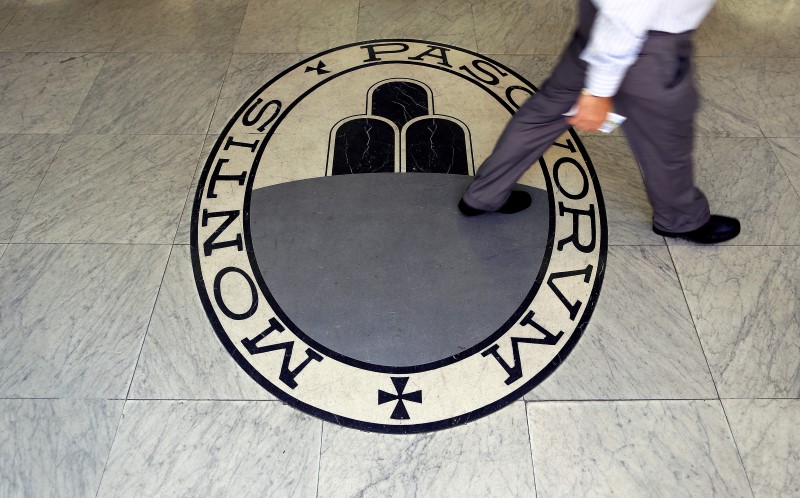By Huw Jones and Valentina Za
LONDON/MILAN (Reuters) - Italy's Monte dei Paschi (MI:BMPS) is once again expected to be among the banks that fare worst in EU stress tests, a concern for investors across Europe who fear its frail finances could destabilise the region's banking system.
The results of the 2016 health check for 51 lenders across the European Union will be published by the European Banking Authority (EBA) at 2100 London time on Friday.
Monte dei Paschi, the world's oldest lender, has become a focus for Italian and European market concern. It is saddled with 47 billion euros (£39.3 billion) of non-performing loans, the largest among big European banks. This, combined with its capital shortfalls, risks creating contagion across the region.
The bank is working on a 5 billion euro capital increase to fix its balance sheet. EU authorities are nevertheless making contingency plans for the possible winding down of the lender if it fares poorly in the tests and no private or public support is available, an EU official said.
The performance of Germany's two biggest lenders, Deutsche Bank (DE:DBKGn) and Commerzbank (DE:CBKG), will also be closely watched after their profitability has come under pressure in recent months.
With no pass or fail mark this time round in the health check - which tests the strength of banks' financial defences to withstand an economic downturn - investors will wait for analysts to crunch 12,000 data points per bank to see which lenders may need to bolster balance sheets.
"The publication of the results is likely to generate major confusion, with each bank likely to spin the outcome in the most positive way in the absence of a clear pass/fail mark from the EBA," analysts at broker Kepler Cheuvreux said.
The European Central Bank said this week that the overall level of capital across the euro zone banks it supervises was already satisfactory and that the tests results were not expected to lead to additional capital demands overall.
The Bank of England has also said that Britain's main lenders have by and large met their overall capital target.
ITALIAN BANKS
Stress tests were introduced in the aftermath of the 2007-09 financial crisis in an attempt to restore investor confidence and get banks lending again to the economy.
But valuations of European banks still lag their rivals in the United States, where regulators are seen as having taken a tougher approach to cleaning up balance sheets, and some EU countries have more work than others to do.
"We believe the EBA stress tests to be published July 29 will result in the authorities needing to address the recapitalisation of Italian banks," said Morgan Stanley (NYSE:MS) analysts, who say Banco Popolare (MI:BAPO) could also fare poorly in the check.
Monte dei Paschi is expected to repeat its poor performance from the last health check nearly two years ago, analysts say.
The Tuscan bank may have to plug a 2 to 6 billion euro capital hole, according to Morgan Stanley, bigger than the 2.1 billion euro shortfall uncovered in the 2014 stress test.
"The bad news is that problems uncovered in 2014 were not acted upon," said banking analyst Nicholas Veron of EU-focused think tank Bruegel. "From a political perspective, we are still in the beginning of a long journey to European banking supervision and Italy is still behind the curve."
VULNERABILITIES
In the 2014 test, banks had to maintain a core capital to risk-weighted assets ratio of 5.5 percent after undergoing a theoretical economic and financial shock.
Analysts say they will apply this threshold to Friday's results, with Morgan Stanley predicting that Spain's Banco Popular (MC:POP) could join Monte dei Paschi and Banco Popolare on the wrong side of this line.
Plumbing 4.5 percent or lower would likely trigger immediate action by regulators, Credit Suisse (SIX:CSGN) said.
Big banks such as Barclays (L:BARC) could face market pressure if they cannot show they are above 6.5 percent, analysts said. Even standing below 7 percent could cause investor concern as this is the level where many bonds or contingent capital issues by banks gets written down, analysts added.
The EU's first two tests plugged capital holes exposed in the financial crisis, a job now largely done, with the focus pf this year's test, the bloc's third, on spotting vulnerabilities in business models.
Regulators like the ECB will use test results for the first time to write their annual "guidance" on how much overall capital each bank should hold.
Banks coming in below this guidance in the test will not, however, face automatic cuts in dividends or bonuses.
"We do believe however that the exercise should improve visibility and support the dividend hike potential," Morgan Stanley said.
The test covers 70 percent of EU banking assets and mimics a three-year financial and economic shock, with new elements such as potential fines and settlements added this time round - Deutsche Bank said earlier this week it hopes to settle its largest litigation cases in 2016.

The tests, however, do not gauge the impact of negative interest rates which are now emerging as a threat to already strained banking profitability.